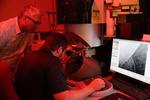Other

“While additive manufacturing (AM), commonly known as 3D printing, is enabling engineers and scientists to build parts in configurations and designs never before possible, the impact of the technology has been limited by layer-based printing methods, which can take up …

“Work is moving fast and furious in the Livermore Computing Complex at Lawrence Livermore National Laboratory (LLNL), where siting and installation for Sierra, the Lab’s next advanced technology high-performance supercomputer, is kicking into high gear. Trucks began delivering racks …

“”Marine grade” stainless steel is valued for its performance under corrosive environments and for its high ductility — the ability to bend without breaking under stress — making it a preferred choice for oil pipelines, welding, kitchen utensils, chemical equipment, medical implants …

“Quantum computing is at the threshold of tackling important problems that cannot be efficiently or practically computed by other, more classical means. Getting past this threshold will require us to build, test and operate reliable quantum computers with 50 or …

“Since its introduction in the 1977 film “Star Wars,” the Death Star has remained one of science fiction’s most iconic figures. The image of Alderaan’s destruction at the hands of the Death Star’s superlaser is burned into …

“Lawrence Livermore National Laboratory researchers have developed a new, more efficient permanent magnet that removes the deficiencies of conventional samarium and neodymium magnets. The proposed magnet stems from the well-known samarium and cobalt (SmCo5, CaCu5-type structure) magnet, but goes a …

“Most of the nuclear reactions that drive the nucleosynthesis of the elements in our universe occur in very extreme stellar plasma conditions. This intense environment found in the deep interiors of stars has made it nearly impossible for scientists to …

“High-speed images of a common laser-based metal 3D printing process, coupled with newly updated computer models, have revealed the mechanisms behind material redistribution, a phenomenon that leads to defects in printed metal parts, Lawrence Livermore National Laboratory (LLNL) researchers reported …

“Lawrence Livermore National Laboratory (LLNL) scientists have developed a technique that helps extract hydrogen from water efficiently and cheaply. Hydrogen can be used as a clean fuel in fuel cells, which produce power, with water and heat as the only …

“Hydrogen at elevated temperature creates high electrical conductivity in the Earth’s mantle. New work by Lawrence Livermore National Laboratory (LLNL) scientists shows the dispersal of water (incorporated as hydrogen in olivine, the most abundant mineral in the upper mantle …
